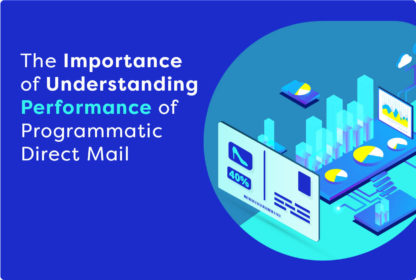Programmatic Direct Mail (PDM) is a formidable player in the world of modern marketing, offering a unique blend of tangible media and agile digital capabilities. But to navigate the hybrid nature of this channel effectively, you need to understand the intricacies of performance and lift measurement for Programmatic Direct Mail.
In this article, we delve into the nuances of performance metrics and lift measurement for Programmatic Direct Mail, shedding light on how PDM can be harnessed to its full potential as a permanent part of your marketing mix.
Programmatic Direct Mail: A Quick Refresher
Before we get into the nitty-gritty of measurement, let’s quickly recap what Programmatic Direct Mail is all about. It’s a powerful performance marketing channel combining the best digital and physical worlds. With it, you can engage addressable audiences with relevant, tangible marketing mail using online intent, machine-learning, and automation.
With PDM, you get a channel that acts a lot like digital when it comes to strategy and execution, only with a longer transaction window. That’s a powerful combination, but one that requires a change in mindset for digitally-native marketers.
Understanding Performance Metrics
Programmatic Direct Mail is a performance marketing channel. That means it’s all about outcomes, not outputs. In fact, many of the metrics used when measuring performance in digital channels are used in Programmatic Direct Mail. Here are some essential metrics to keep your eye on:
- Sends: A basic view into scale and pacing. This is the total number of Programmatic Direct Mail pieces or messages sent to the intended recipients within a campaign.
- Spend: The total budget or expenditure allocated to create, execute, and measure the effectiveness of a Programmatic Direct Mail campaign.
- Conversion Rate: This one’s a classic. It tells you how many of the recipients took the desired action – be it making a purchase, signing up for a service, or visiting a store.
- Cost per Action: To make sure you’re getting the most bang for your buck, keep an eye on how much you’re spending for each conversion.
- Response Rate: This metric shows how many people engaged with your mail piece in some way. Responses can be anything from a website visit to a phone call to actually walking into a store.
- Return on Ad Spend (ROAS): The ultimate measure of success, ROAS quantifies the effectiveness and profitability of a PDM campaign by comparing the revenue generated to the total cost of running the campaign.
- AOV (Average Order Value): The average monetary value of orders or transactions generated from the campaign, helping measure the profitability of individual customer interactions.
When dealing with longer transaction and attribution windows like PDM, these metrics provide early insights into how your program is pacing and performing and where there might be room for improvement.
Approaching Lift Measurement
Lift measurement is all about understanding the impact of your Programmatic Direct Mail program compared to what would have happened without it. It also helps you to take a data-driven approach to finding the right attribution window for your brand. This is a bit more advanced but incredibly valuable. Here’s how to approach it:
- Control Groups: These are essential for providing a baseline to measure lift. A control groups is a segment of your target audience that hasn’t been exposed to your PDM marketing. You can estimate the true lift by comparing the performance of the control group with the exposed group. (It’s worth noting there are a few different ways to approach control groups we won’t be getting into here, so align with your PDM partner before implementing.)
- Attribution Windows: This represents a specific time period during which credit is assigned to various touchpoints or interactions that contributed to a conversion or user action. For Programmatic Direct Mail, the standard attribution window is 60-90 days. That’s the average amount of time it takes for an exposed group’s performance to converge with that of the control group.

- Benchmarking and Projections: As you continue to scale, compare your lift results to industry benchmarks or your own historical data. This can help you understand whether your campaign’s performance is above or below expectations.
Longer Transaction Windows Mean Longer Attribution Windows
Compared to its digital channel attribution windows (typically 15-30 days), the standard PDM attribution window might feel a bit long. But the longer attribution window is necessary, even beneficial, for a number of reasons:
- The time a piece of mail is “viewable” in the home is much longer than a digital impression. While digital messages are in view for 1-30 seconds, relevant marketing mail lives in the home for up to 17 days on average. That makes the transaction window much longer than that of a digital ad.
- There are no “clicks” in offline media. Clicks provide both an early indicator or performance and an immediate path to a transaction for digital campaigns. QR codes have gone a long way in starting to close that divide, but they are not nearly as ubiquitous as a “click” just yet.
- Frequency capping in digital is a totally different kettle of fish than physical media. A digital ad can be served to someone multiple times weekly or even daily. That’s not the case with physical media. Paper is proven to be much harder to ignore than digital ads, so receiving the same marketing mail over and over during a brief period results in a poor customer experience.
While starting with the standard attribution window is always recommended, every brand, customer base, and industry is different. Work with your PDM partner to understand the patterns in lift to calculate the ideal attribution window for your brand based on a comparison of your program’s exposed and control groups.
The Path to Success
In the ever-evolving world of Programmatic Direct Mail, understanding and effectively measuring performance and lift are essential. These metrics provide valuable insights that can guide your programs to success.
Remember, PDM is a powerful tool but is not a one-size-fits-all solution. Continuously monitor and adjust your programs to achieve the best results, and don’t be afraid to experiment with new strategies.
So there you have it, my friends! Now, you’re equipped with the knowledge to rock your Programmatic Direct Mail programs like a pro. Keep tracking those performance metrics and measuring lift and you’ll be well on your way to marketing greatness.



